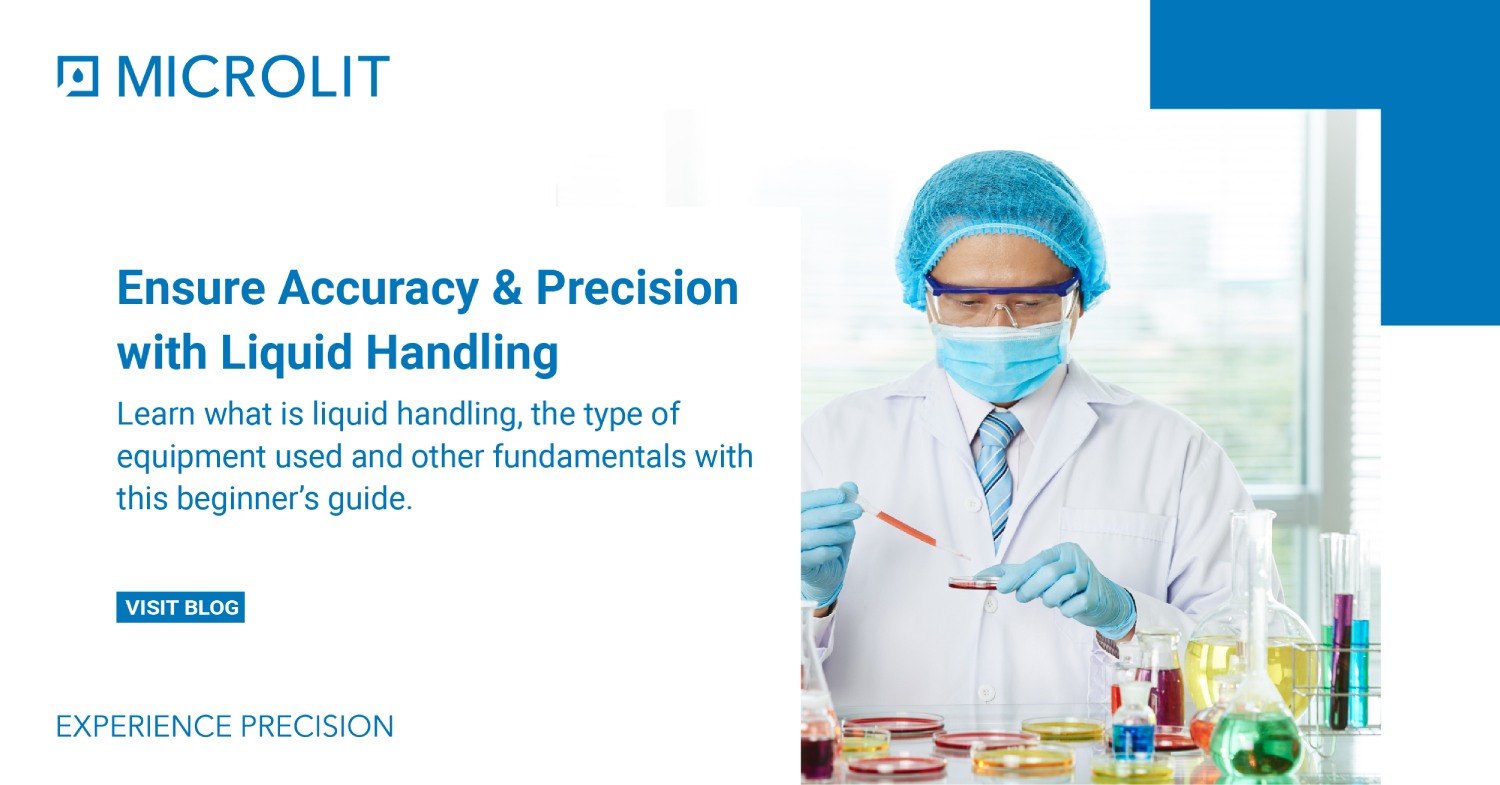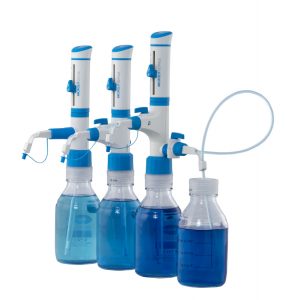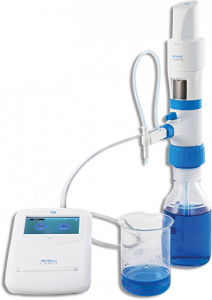What is Liquid Handling
Liquid handling is the act of transferring reagents from one location to another, say from one apparatus to another, for testing purposes in a laboratory. Liquid handling might seem like an easy task at first but the precision with which it is done is strenuous & crucial. The samples used are often minute and as small as 1 microlitre but even these tiny quantities of reagents help researchers discover chemicals, detect diseases and so on.
Liquid handling is the core of many laboratory processes and takes place on a daily basis.
Though it might seem like an easy process, liquid handling is highly significant while carrying out experiments and studies, clinical application, identifying new elements. The use of liquid handling instruments enables the researcher to accurately complete their studies eliminating the risk of human error and at the same time eliminating the risk of contamination.
Understanding the Properties of the Reagents Used
Before beginning the liquid handling process, it is crucial for researchers to understand the nature of the reagents and the liquid class they fall under. There are instruments that are compatible with different kinds of reagents. For instance, strong reagents like Hydrofluoric Acid cannot be dispensed by a basic bottle top dispenser. The Microlit Lentus has been specifically designed to dispense such strong acids and ensure the accuracy of the studies carried out. A suitable liquid class allows the handler to know how he/she should interact with the reagent and prevent mishandling.
Examples of Synonymous Liquid Classes
| Aqueous Solution | Volatile Organic Solvents | Involatile Organic Solvents | Viscous Liquid | Blood Products |
| Water | Ethanol | Dimethyl Sulfoxide (DMSO) | Glycerol | Serum |
| PBS | Isopropanol | Alkane | Beads | Plasma |
| Master Mix | Acetone | – | Oil | Whole Blood |
Types of Liquid Handling Instruments
There is a myriad range of liquid handling instruments, each used for different purposes. These instruments can be automated, semi-automated and manual. Here, we will be discussing the commonly used, manually operated liquid handling instruments. One such customary yet essential laboratory instrument is the Micropipette.
Available in single-channel and multi-channel variants, micropipettes are used to accurately and precisely transfer volumes of liquid in the microliter range. While the single-channel micropipettes are used in labs that perform research related to molecular biology, microbiology, immunology, cell culture, analytical chemistry, biochemistry and genetics, the multichannel micropipettes are recommended for ELISA (diagnostic test), molecular screening, kinetic studies and DNA amplification.
Another key instrument used in a laboratory for the accurate and safe transfer of chemicals is the Bottle Top Dispenser. Available in different volumes, bottle top dispensers can be mounted on the laboratory reagent bottles for convenient dispensing of chemicals.
The process of dispensing manually poses multiple risks like spilling of chemicals, inaccurate measurements and even fatal lab accidents. In order to prevent such hazards and enhance lab safety, Bottle Top Dispensers are one of the best dispensing alternatives available to scientists.
Bottle Top Dispensers also enhance productivity by increasing the pace of work. It could take hours to prepare multiple samples of the same quantity when reagents are being poured by hand from the source container to the receiver container. However with Bottle Top Dispensers, multiple samples can be prepared within a short span of time.
Most of the dispensers operate on a spring based valve. However, there are certain drawbacks of having a spring in the outlet valve.
- Spring Metal ReactivityDepending on the application, the spring in the outlet valve is either made of Platinum Iridium or Tantalum. Platinum Iridium is not suitable for Hydrogen Peroxide whereas Tantalum has limitations with Sodium Hydroxide. Because of this spring metal reactivity, the user has to procure different kinds of Bottle Top Dispensers for different applications which adds confusion and proves to be an expensive proposition.
- Chemical DepositionThe spring also offers a surface for deposition of chemicals. This results in a piston jam, thereby compelling the user to repeatedly clean the valve, or replace it altogether.
Microlit Bottle Top Dispensers which work on the SpringlessTM Valve Technology are best known to avoid problems related to the spring metal reactivity and chemical deposition. They offer approximately 0.5% to 0.6% accuracy. An added benefit is the FlexiNozzleTM which is a narrow delivery tube which makes dispensing into small-sized containers (like a test tube) convenient.
Other than micropipettes and bottle top dispensers, burettes are one of the widely used instruments used in analytical chemistry for the accurate dispensing of a liquid, especially the reagents used in a titration experiment. The process of titration involves determining the concentration of a solution with the help of another solution with known concentration. Typically, the titrant (solution of known concentration) is added using a burette to an analyte (the second solution) until the reaction is complete. Often, a visual indicator (buffer or pH solution) is used to signal the completion (end-point). Since the volume of the titrant is already known, one can easily determine the concentration of the analyte, using the formula of titration.
The different types of burettes available for titration include the glass burettes, auto burettes, digital burettes and electronic burettes.
While the glass and auto burettes are the traditional titration instruments (often used in the laboratories of schools and universities), the digital and electronic burettes are one of the novel titration instruments. Compared to the traditional burettes, the digital and electronic burettes are convenient & easy to use and provide accurate and precise results in a much lesser time.
Microlit E-Burette is one such electronic burette which makes the titration process quick and convenient. With its motor-controlled piston movement, digital display, touch screen operation and three speeds of operation- fast, medium and dropwise, the E-Burette is one of the leading solutions to perform accurate titrations.
The following table summarizes the selection of liquid handling instruments (discussed above) based on their primary usage criterion:
| Instrument to be used | Primary usage | Example |
| Single Channel Micropipette | Dispensing fixed volume of a liquid/reagent in the microlitre range into a vial, test tube, petri dish, beaker, etc. | Transferring samples related to cell culture, molecular biology, microbiology, immunology, genetics etc. |
| Multi Channel Micropipette | Dispensing fixed volume of a liquid/reagent in the microlitre range into assay plates, elisa trays, 96 well plates etc. | Used in ELISA (diagnostic test), molecular screening, kinetic studies, DNA amplification etc. |
| Bottle Top Dispenser | Dispensing fixed volume of a liquid/reagent in the millilitre range into a beaker, flask, test tube etc. | Used for sampling and analysing Active Pharmaceutical Ingredients (APIs), impurities, excipients etc. |
| Burette | Performing titration by adding the titrant (solution of known concentration) to the analyte (the second solution) contained in a titration flask. | Determining the amount of chloride/calcium ions present in ground water thereby finding the hardness of groundwater. |
The following summarizes the selection of liquid handling instruments (discussed above) based on their primary usage criterion:
Instrument to be used :
1. Single Channel Micropipette
Primary usage
Dispensing fixed volume of a liquid/reagent in the microlitre range into a vial, test tube, petri dish, beaker, etc.
Example
Transferring samples related to cell culture, molecular biology, microbiology, immunology, genetics etc.
2. Multi Channel Micropipette
Primary usage
Dispensing fixed volume of a liquid/reagent in the microlitre range into assay plates, elisa trays, 96 well plates etc.
Example
Used in ELISA (diagnostic test), molecular screening, kinetic studies, DNA amplification etc.
3. Bottle Top Dispenser
Primary usage
Dispensing fixed volume of a liquid/reagent in the millilitre range into a beaker, flask, test tube etc.
Example
Used for sampling and analysing Active Pharmaceutical Ingredients (APIs), impurities, excipients etc.
4. Burette
Primary usage
Dispensing fixed volume of a liquid/reagent in the millilitre range into a beaker, flask, test tube etc.
Example
Used for sampling and analysing Active Pharmaceutical Ingredients (APIs), impurities, excipients etc.
On a concluding note
A process of major importance, accurate and precise liquid handling can set the base for most landmark scientific research and studies. Even the slightest error during the process can result in the failure of the study or getting an undesired result. The use of a correct liquid handling instrument reduces the risk of human errors, prevents wastage of resources, ensures the safety and gives precise and accurate results with high efficiency. Thus, it is important to have the right instrument to perform the liquid handling process right.
To enquire about Microlit’s range of liquid handling instruments, send us an email on info@sashwatlabsolutions.com.
![]()




